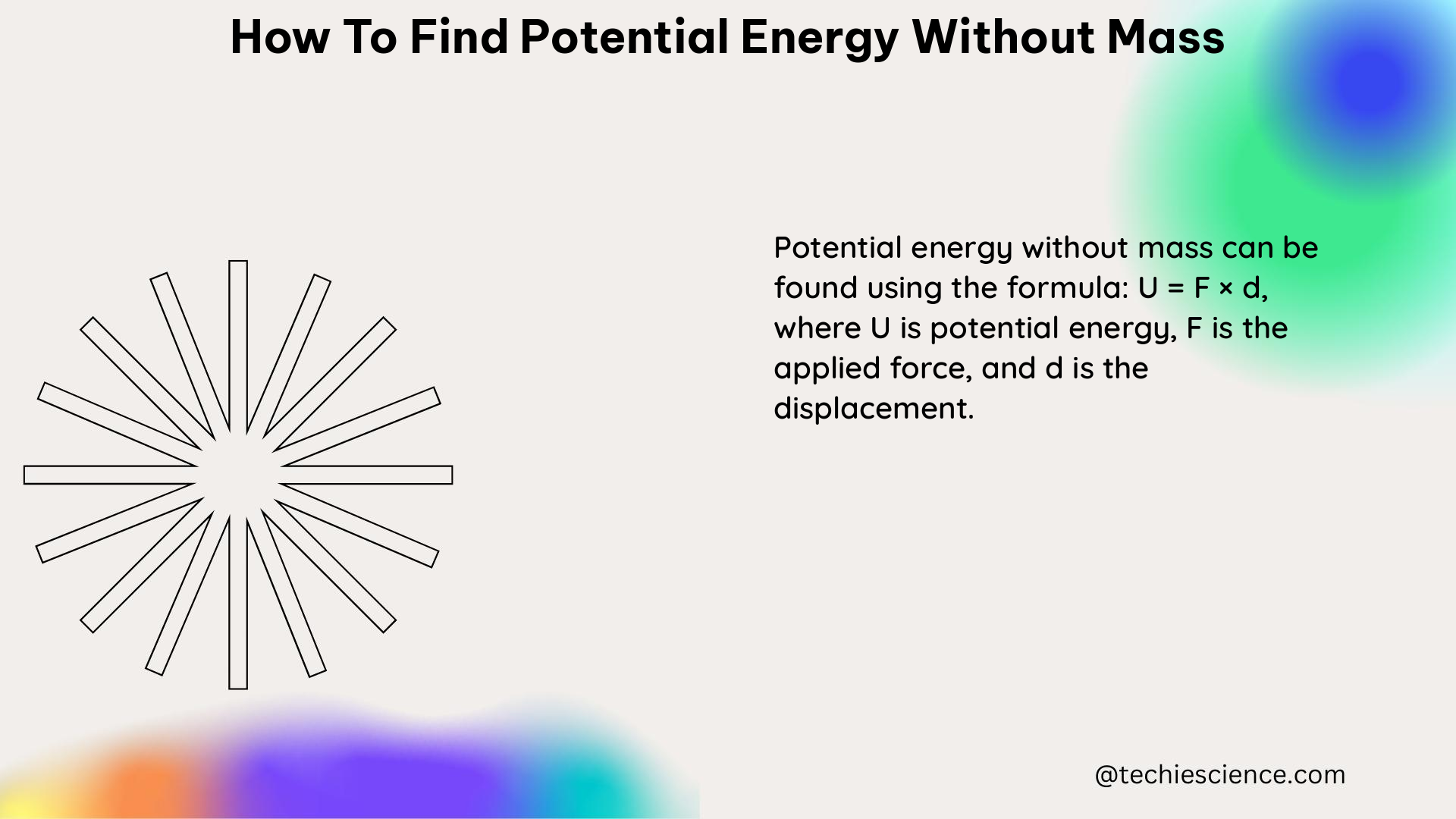Potential energy is a fundamental concept in physics, describing the energy stored within a system due to its position or configuration. While the traditional approach to calculating potential energy involves the mass of the object, it is possible to determine potential energy without explicitly considering the mass. This comprehensive guide will delve into the principles, formulas, and practical applications of finding potential energy without mass, providing a valuable resource for physics students and enthusiasts.
Understanding Potential Energy and Conservative Forces
Potential energy is defined as the work done by a conservative force. A conservative force is a force that depends solely on the position of the object, and the work done by this force is independent of the path taken. Gravitational force is a prime example of a conservative force, where the potential energy of an object is determined by its position relative to the Earth’s surface.
The general formula for potential energy (U) is:
U = ∫ F(x) dx
Where F(x) is the conservative force acting on the object, and the integration is performed over the displacement of the object.
Potential Energy Without Mass: The Gravitational Approach

When considering potential energy without mass, we can focus on the gravitational force acting on the object. The gravitational force (F) is given by the formula:
F = G * (m1 * m2) / r^2
Where:
– G is the gravitational constant (6.674 × 10^-11 N⋅m^2/kg^2)
– m1 and m2 are the masses of the two objects
– r is the distance between the objects
If we assume that m2 is much larger than m1, effectively making m2 infinite, the force becomes:
F = G * m1 / r^2
Now, let’s consider a massless object at a height h above the ground. The potential energy (U) of this object can be found by calculating the work done by the gravitational force over the distance h.
The work (W) done is given by:
W = F * d
Where:
– F is the force (G * m1 / h^2)
– d is the distance (h)
Substituting the values, we get:
W = G * m1 / h
Since U = W, the potential energy of the massless object is:
U = G * m1 / h
This formula allows us to calculate the potential energy of a massless object without explicitly using its mass.
Examples and Numerical Problems
- Example 1: A massless object is placed at a height of 10 meters above the ground. The gravitational constant (G) is 6.674 × 10^-11 N⋅m^2/kg^2. Calculate the potential energy of the massless object.
Given:
– Height (h) = 10 meters
– Gravitational constant (G) = 6.674 × 10^-11 N⋅m^2/kg^2
Potential energy (U) = G / h
U = 6.674 × 10^-11 N⋅m^2/kg^2 / 10 m
U = 6.674 × 10^-12 J
- Numerical Problem 1: A massless object is placed at a height of 5 meters above the ground. The gravitational constant (G) is 6.674 × 10^-11 N⋅m^2/kg^2. Calculate the potential energy of the massless object.
Given:
– Height (h) = 5 meters
– Gravitational constant (G) = 6.674 × 10^-11 N⋅m^2/kg^2
Potential energy (U) = G / h
U = 6.674 × 10^-11 N⋅m^2/kg^2 / 5 m
U = 1.3348 × 10^-11 J
- Numerical Problem 2: A massless object is placed at a height of 15 meters above the ground. The gravitational constant (G) is 6.674 × 10^-11 N⋅m^2/kg^2. Calculate the potential energy of the massless object.
Given:
– Height (h) = 15 meters
– Gravitational constant (G) = 6.674 × 10^-11 N⋅m^2/kg^2
Potential energy (U) = G / h
U = 6.674 × 10^-11 N⋅m^2/kg^2 / 15 m
U = 4.4493 × 10^-12 J
Limitations and Considerations
It’s important to note that while the formula U = G / h allows us to calculate potential energy without explicitly using mass, the mass of the larger object (m1) is still present in the underlying principles. Potential energy is always associated with a mass and a force, and the mass is still a factor in the overall potential energy of the system.
Additionally, the assumption that m2 is much larger than m1, effectively making m2 infinite, is a simplification that may not always hold true in real-world scenarios. In such cases, the full formula F = G * (m1 * m2) / r^2 should be used to determine the potential energy.
Conclusion
Finding potential energy without mass is a valuable skill in physics, as it allows for a more generalized understanding of the concept. By focusing on the conservative force and the distance over which it acts, we can derive a formula that enables the calculation of potential energy without explicitly considering the mass of the object. This approach can be particularly useful in scenarios where the mass of the object is unknown or irrelevant to the problem at hand.
The comprehensive guide provided in this blog post covers the fundamental principles, formulas, and practical examples to help physics students and enthusiasts master the concept of finding potential energy without mass. By understanding this technique, you can expand your problem-solving abilities and gain a deeper appreciation for the intricacies of energy conservation and the role of conservative forces in the physical world.
References:
- How do we know that there is potential energy if there is no mass?
- Kinetic Energy and Velocity
- How to find KE and PE without mass

The lambdageeks.com Core SME Team is a group of experienced subject matter experts from diverse scientific and technical fields including Physics, Chemistry, Technology,Electronics & Electrical Engineering, Automotive, Mechanical Engineering. Our team collaborates to create high-quality, well-researched articles on a wide range of science and technology topics for the lambdageeks.com website.
All Our Senior SME are having more than 7 Years of experience in the respective fields . They are either Working Industry Professionals or assocaited With different Universities. Refer Our Authors Page to get to know About our Core SMEs.